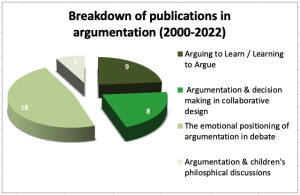Argumentation in different flavors

My work in argumentation and explanation began with their recognition as crucial mechanisms for building common ground: The importance of gaze and gesture in interactive mulitmodal explanation(1) and favoring learning: Promoting reflective interactions in a computer-supported collaborative learning environment(2) during foundational work with Michael Baker, this latter before 2000. Early on, my work focused on elaborating pedagogical scenarios in which instructions, task sequences, tools and guidance are evaluated for their capacity to provoke high quality argumentation and explanation, in which students are disentangling new concepts e.g. How do argumentation diagrams compare when student pairs use them as a means for debate or as a tool for representing debate?(3) or Computer-Mediated Epistemic Dialogue: Explanation and Argumentation as Vehicles for Understanding Scientific Notions(4). It proved interesting to transfer these theoretical and analytical approaches to studying argumentation into professional contexts: e.g. mechanical and electrical engineers’ decision making: An empirical study of engineering knowledge dynamics in a design situation(5)
However, argumentation is also impacted by social aspects How a power game shapes expressing opinions in a chat and in an argument graph during a debate: A case study(6). And emotion is an integral part of reasoning as illustrated through socio-scientific debates e.g. Group emotions in collective reasoning: a model(7) and Group Emotions: The Social and Cognitive Functions of Emotions(8). Finally, philosophy discussions with children has provided fascinating corpora for studying how emotion and cognition intermingle with social and cultural aspects of interaction: La saisie émotive du kairos avec des enfants: entre acte philosophique et geste didactique [The emotive grasp of kairos with children: between a philosophical act and a didactical gesture](9).
(1) Lund, K (2007). The importance of gaze and gesture in interactive mulitmodal explanation. International Journal of Language Resources and Evaluation, 2007, 41 (3-4), pp.289-303. ⟨1007/s10579-007-9058-0⟩. ⟨halshs-00373412⟩
(2) Baker, M., Lund, K. (1997). Promoting reflective interactions in a computer-supported collaborative learning environment. Journal of Computer Assisted Learning, 1997, 13, pp.175-193. 1046/j.1365-2729.1997.00019.x⟨halshs-00195341⟩
(3) Lund, K., Molinari, G., Séjourné, A. et al.How do argumentation diagrams compare when student pairs use them as a means for debate or as a tool for representing debate?. Computer Supported Learning 2, 273 (2007). https://doi-org.inshs.bib.cnrs.fr/10.1007/s11412-007-9019-z
(4) de Vries, E., Lund, K. & Baker, M.(2002) Computer-Mediated Epistemic Dialogue: Explanation and Argumentation as Vehicles for Understanding Scientific Notions, Journal of the Learning Sciences, 11:1, 63-103, DOI: 1207/S15327809JLS1101_3
(5) Prudhomme, G., Pourroy, F., & Lund. K. (2007). An empirical study of engineering knowledge dynamics in a design situation. Journal of Design Research, 2007, 6 (3), pp.333-358. ⟨hal-00180692⟩
(6) Molinari, G. & Lund., K. (2021). How a power game shapes expressing opinions in a chat and in an argument graph during a debate: A case study. The Future of Learning: Proceedings of the 10th International Conference of the Learning Sciences (ICLS 2012), Jul 2012, Sydney, Australia. pp.232-236. ⟨halshs-01491999⟩
(7) Polo, C., Plantin, C., Lund, K., & Niccolai., G.P. (2017) Group Emotions in Collective Reasoning: a Model. Argumentation, 2017, 31 (2), pp.301-329. ⟨1007/s10503-016-9407-5⟩. ⟨halshs-01381013⟩
(8) Polo, C., Lund, K., Plantin, C., & Niccolai., G.P. (2016). Group Emotions: The Social and Cognitive Functions of Emotions. International Journal of Computer-Supported Collaborative Learning (ijCSCL), 2016, 11 (2), pp.123-156. ⟨halshs-01381014⟩
(9) Polo, C. & Lund, K. (2021). La saisie émotive du kairos avec des enfants : entre acte philosophique et geste didactique [The emotive grasp of kairos with children: between a philosophical act and a didactical gesture]. Studia UBB, 2021, 66, 3, pp.103-134. ⟨hal-03583592⟩
